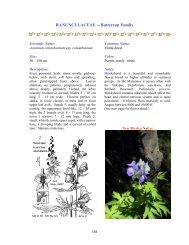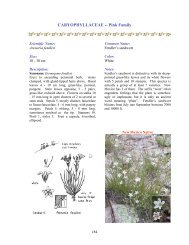BERBERIDACEAE -- Barberry Family - New Mexico Flores
BERBERIDACEAE -- Barberry Family - New Mexico Flores
BERBERIDACEAE -- Barberry Family - New Mexico Flores
Create successful ePaper yourself
Turn your PDF publications into a flip-book with our unique Google optimized e-Paper software.
Scientific Name:<br />
Conringia orientalis<br />
Size:<br />
20 - 60 cm<br />
BRASSICACEAE -- Mustard <strong>Family</strong><br />
Description:<br />
Erect annual or winter annual herb, stems<br />
mostly solitary, glabrous, with a waxy whitish<br />
coating. Basal leaves smooth-edged, tapered to<br />
the base. Stem leaves alternate, smooth-edged,<br />
elliptic, oval or oblong, sessile, leaf bases<br />
wrapping the stem, glabrous. Flowers perfect,<br />
on upward curving stalks 5 - 15 mm long, in a<br />
loose cluster at stem end. Sepals 4, erect, 4 - 6<br />
mm long, glabrous, often reddish tinged. Petals<br />
4, narrowly obovate, 10 - 12 mm long, with a<br />
long, tapered, narrow base. Stamens 6, 4 equal,<br />
2 shorter. Fruit a long, narrow, 4-angled pod, 8-<br />
12 cm long, 2 - 3 mm in diameter, pointing<br />
upward.<br />
149<br />
Common Name:<br />
Hare’s-ear mustard<br />
Color:<br />
White to creamy white<br />
Notes:<br />
Hare’s-ear mustard has been naturalized from<br />
Eurasia. Wooten and Standley in their 1915<br />
Flora of <strong>New</strong> <strong>Mexico</strong> show it localized near Des<br />
Moines, NM. Martin and Hutchins in their<br />
1980 A Flora of <strong>New</strong> <strong>Mexico</strong> show it in both<br />
Colfax and Union counties. By the mid-1990’s<br />
it appeared in the Manzanos. When mature, its<br />
pods are the longest of all the mustards in the<br />
Manzanos. Hare’s-ear mustard blooms from<br />
April into June between 4500 and 7500 ft.<br />
Introduced*




